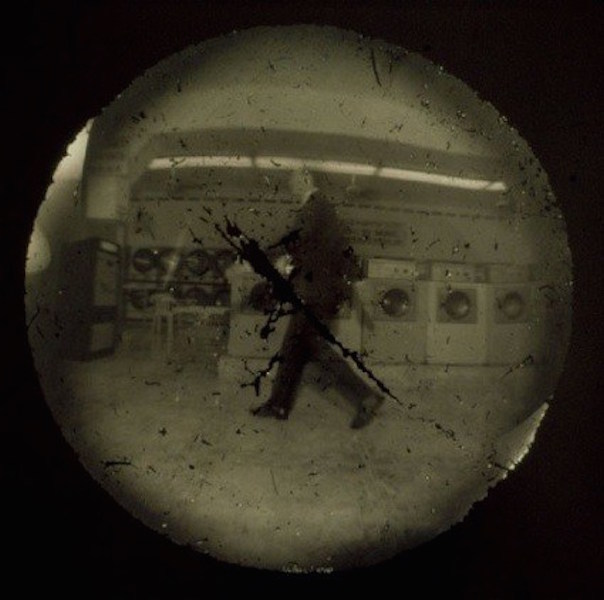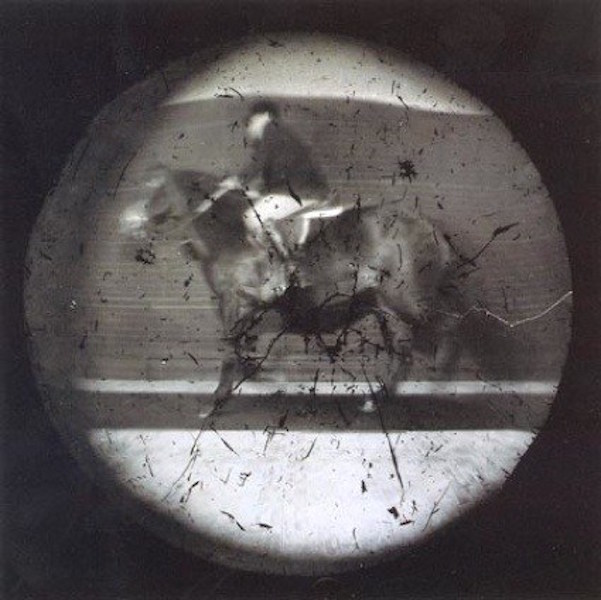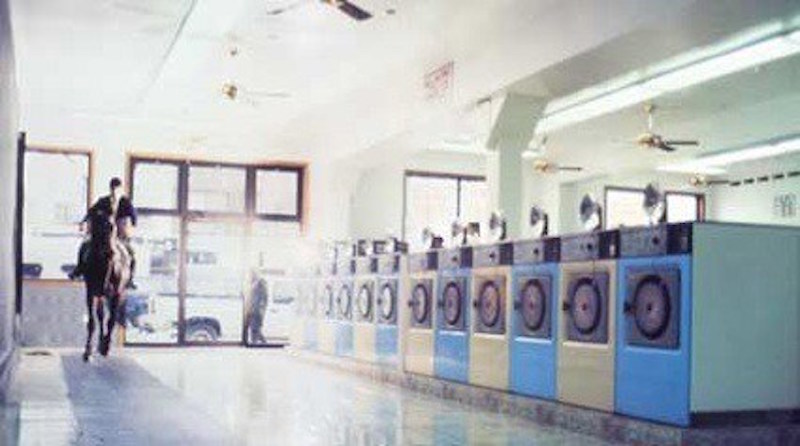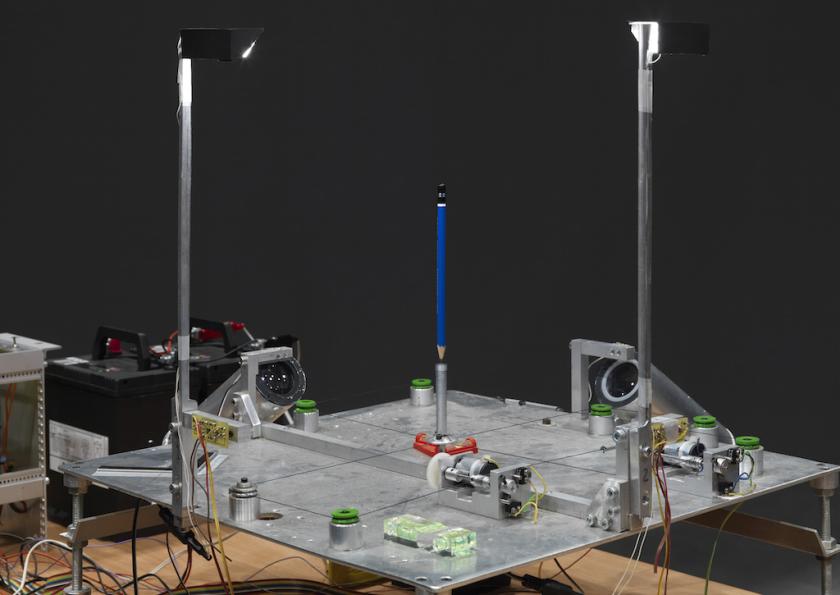Our universe seems to be in a state of equilibrium, neither collapsing in on itself nor expanding ad infinitum. The metaphor used by physicists to represent the delicate balance of forces needed to maintain this happy state of affairs is a pencil standing on its tip. In his sculpture Omega = 1, Steven Pippin miraculously turns the metaphor into physical reality.
It took him 10 years to perfect a system that would keep a pencil balanced atop a steel rod without any support. The secret lies in the shadows cast by two lights shining onto the shaft; monitoring the shadows are sensors that respond to the slightest shift by making tiny adjustments to the alignment of the rod. Trembling like a strong man lifting an acrobat, the rod subtly modifies its position to keep the pencil poised effortlessly upright.
I can’t even imagine the complex electronics and fine tuning required to achieve this miraculous balancing act. As an artist, Pippin was attracted by the absurdity and apparent impossibility of the enterprise; but he also studied engineering, and this unique combination of vision and knowledge enabled him to complete the task.
 Omega = 1 serves no practical purpose other than being a beautiful and extremely satisfying illustration of a scientific principle. Begun in 2016, His Static Energy Turbine System, on the other hand, may eventually have some practical application. As the air rotates the blades of a wind turbine, static electricity is generated; but no attempt has so far been made to capture this residual energy. Working with inventor Steven Davis, Pippin has installed a small wind turbine inside a wind tunnel. The blades are coated with gold leaf which conducts the static electricity and stores it in the housing, while sensors monitor every aspect of the research. Built especially for this exhibition at the University of Bath, the model is described as an “ideas machine”, which begs the question as to whether it is a sculpture, a scientific experiment or both.
Omega = 1 serves no practical purpose other than being a beautiful and extremely satisfying illustration of a scientific principle. Begun in 2016, His Static Energy Turbine System, on the other hand, may eventually have some practical application. As the air rotates the blades of a wind turbine, static electricity is generated; but no attempt has so far been made to capture this residual energy. Working with inventor Steven Davis, Pippin has installed a small wind turbine inside a wind tunnel. The blades are coated with gold leaf which conducts the static electricity and stores it in the housing, while sensors monitor every aspect of the research. Built especially for this exhibition at the University of Bath, the model is described as an “ideas machine”, which begs the question as to whether it is a sculpture, a scientific experiment or both.
Pippin is happy to situate himself somewhere between the two worlds. In 1999 he was shortlisted for the Turner Prize and, until then, had turned his back on engineering. “I hated it,” he told me at the time, “because my father and grandfather where engineers... I’ve reverted to technology now but for a long time I wouldn’t touch it; I blocked it out. I tried to make gears out of card, when I had the knowledge to machine the parts!”
 He became obsessed with photography and began converting things including a wardrobe, bath, lavatory cistern and whole rooms into pinhole cameras. The installation he created for the Turner Prize charted his conversion of the washing machines in a launderette into a bank of cameras that recorded clothed and naked figures (pictured above right) and a horse galloping past (pictured above left). The project was in homage to Eadweard Muybridge, famous for proving that galloping horses lift all their hooves off the ground. The studies Muybridge made in the 1870s of human and animal locomotion are legendary not just for their strange beauty, but also for the determination with which he pursued his goal.
He became obsessed with photography and began converting things including a wardrobe, bath, lavatory cistern and whole rooms into pinhole cameras. The installation he created for the Turner Prize charted his conversion of the washing machines in a launderette into a bank of cameras that recorded clothed and naked figures (pictured above right) and a horse galloping past (pictured above left). The project was in homage to Eadweard Muybridge, famous for proving that galloping horses lift all their hooves off the ground. The studies Muybridge made in the 1870s of human and animal locomotion are legendary not just for their strange beauty, but also for the determination with which he pursued his goal.
Pippin demonstrates a similar degree of determination. For him the process has always been as important as the end product; his Tate exhibition included the equipment he designed to convert the washing machines and a video of the event (pictured below), as well as the final photographs. On show in Bath are sculptures made since his Turner Prize nomination; emphasis has shifted from a fascination with photography to the mass media and our reliance on communication technology in general.
A recurring theme is our propensity to become couch potatoes, experiencing the world through televised images rather than direct interaction. New Constellation, 1999, is a model of the solar system; among the planets orbiting the sun is a man watching television. The earth has been replaced by its onscreen image. Geostationary TV Set, 1996-98, looks like an old-fashioned globe, but in place of the sphere is a television screen broadcasting a picture of a globe. In Geocentric TV, 1998, the screen is suspended from its stand at an angle of 23 degrees, the same as the earth’s axis. Visible on screen is an image of our rotating planet; meanwhile, the set rotates anti-clockwise at the same speed. Watching the contradictory movements of screen and image made me feel nauseous and writing about the work induces the same queasiness. Is Pippin suggesting that our relationship with our planet is making us ill?
Geostationary TV Set, 1996-98, looks like an old-fashioned globe, but in place of the sphere is a television screen broadcasting a picture of a globe. In Geocentric TV, 1998, the screen is suspended from its stand at an angle of 23 degrees, the same as the earth’s axis. Visible on screen is an image of our rotating planet; meanwhile, the set rotates anti-clockwise at the same speed. Watching the contradictory movements of screen and image made me feel nauseous and writing about the work induces the same queasiness. Is Pippin suggesting that our relationship with our planet is making us ill?
Global Wastepaper Basket, 2015, suggests, rather too literally, the serious repercussions of our emotional and physical disengagement from our surroundings. A hole has been cut in the globe and a plastic bag stuffed inside to receive rubbish; for many of us the earth has become little more than a repository for rubbish or a resource to be exploited.
Fax, 1998/9, wittily demonstrates our obsession with technology and ourselves, and our consequent disregard of everything else. Sitting side by side are two fax machines linked together in an endless electronic loop – doomed to feed the same information back and forth to one another, ad infinitum. And, of course, the paper is blank; we have nothing consequential to say.
The irony at the heart of Pippin’s work is that the technology he exploits so eloquently is a major source of the malaise he identifies. His own obsession with technology is palpable; at least he uses it, though, to create poetic ruminations on the dangers of our over-reliance on it.
- Engineered Equanimity: The Machines of Steven Pippin at The Edge, University of Bath until 3 February
- Read more visual arts reviews on theartsdesk










![SEX MONEY RACE RELIGION [2016] by Gilbert and George. Installation shot of Gilbert & George 21ST CENTURY PICTURES Hayward Gallery](/sites/default/files/styles/thumbnail_125_x_125_/public/mastimages/Gilbert%20%26%20George_%2021ST%20CENTURY%20PICTURES.%20SEX%20MONEY%20RACE%20RELIGION%20%5B2016%5D.%20Photo_%20Mark%20Blower.%20Courtesy%20of%20the%20Gilbert%20%26%20George%20and%20the%20Hayward%20Gallery._0.jpg?itok=3oW-Y84i)




Add comment